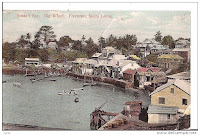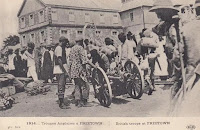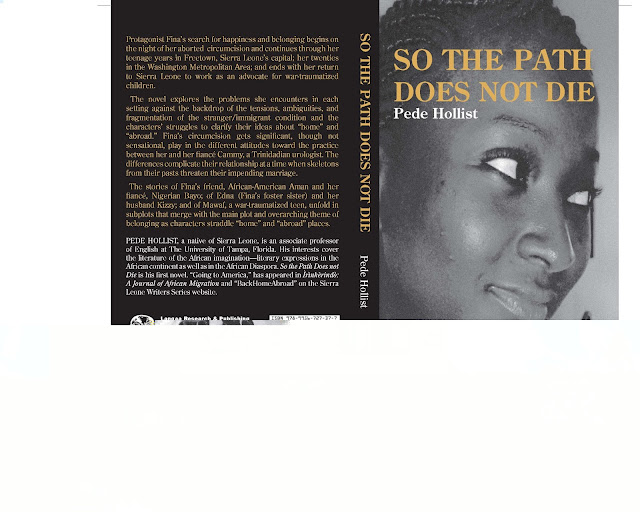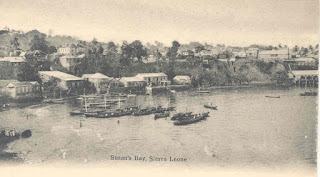Constance and Nancy and Everyone They Knew | Fantasy History 1
Five days a week, Nancy Dolly Grant would walk past the
Princess Christian Mission Hospital on the eastern side of Freetown to an old produce
port at Susan's Bay, Big Wharf.
The Princess Christian Mission hospital that lies back from the
old Fourah Bay road, along which ran railway track, was established in
1892 as a teaching hospital for "training African ladies in nursing and in
ministering to the spiritual and bodily needs of the sick and poor."
The premises had a large free ward for women and children, a
small ward for paying patients, a ward for European missionaries, consulting
room, operating room and a residence for the European matron and sisters.
Two miles away, on the west side of town, near the waterside market at King Jimmy, was the much larger government-run hospital, Connaught Hospital, that was opened in 1910 by the English duke of Connaught, Arthur.
Two miles away, on the west side of town, near the waterside market at King Jimmy, was the much larger government-run hospital, Connaught Hospital, that was opened in 1910 by the English duke of Connaught, Arthur.
Young Nancy’s “greatest ambition” was to be a nurse.
Between the two hospitals ran narrow, congested streets,
overcrowded with trading stalls and little houses packed with families.
One of those families was Nancy’s.
One of those families was Nancy’s.
This is how Nancy recalled her 1920s childhood in a private communication with Filomina C. Steady. Dr. Steady has written seminal books on African women’s movement and the
impact of collective action on economic growth, education, democratizations,
family formation, and women's rights.
“We only had two easy chairs for grownups; children did not dare sit on them. We sat on kerosene boxes instead. We had to scrub the chairs and boxes every Saturday and we covered the boxes with antimacassars to make them more decent and comfortable. Our floor was not made of wood or concrete but of plain earth. We never ate our main meal before 7 or 8 p.m. because every day after school we, the girls, had to help my mother to trade at Big Wharf before she could get enough money to buy food for the main meal. We used to go home at about 6 or 7 p. m to cook. We went hungry for a long time and had to do the cooking on empty stomachs.” -- Nancy Steele
Reporting from Freetown for the Chicago Tribune Foreign News Service in October of 1923, Floyd Gibbons found people who had taxation without representation.
“Among them are educated Negroes, college graduates, both men and women, who are lawyers, doctors, judges, engineers, preachers, and editors of five weekly newspapers. …Some of the women wear evening gowns and sit on the right of the governor at dinner and fill their programs with the names of young Englishmen. Others use sackcloth for adornment and wear string above the waist but a pickanny strapped to the back. …These black British subjects in Sierra Leone are not in sympathy with the political independence program of Marcus Garvey and American promotion of the Universal Negro Improvement Association.”
By 1924, Sierra Leone was divided into a Colony and a
Protectorate, with separate and different systems constitutionally defined for each.
Joining the dots was Isaac Theophlilus Akuna Wallace-Johnson.
Joining the dots was Isaac Theophlilus Akuna Wallace-Johnson.
Born into a poor Krio family in Wilberforce Village, he attended mission
schools in the colony. At the age of eighteen, he entered government service as
a customs clerk, but was dismissed for helping to organize the first trade
union in Sierra Leone. After serving as a clerk in the Carrier Corps, he joined
the merchant marine as a sailor, later editing a newspaper in London dedicated
to promoting the welfare of seamen.
In 1931, Wallace-Johnson founded the first labor union in Nigeria, and in 1936 he was jailed in the Gold Coast (Ghana) for publishing a scathing attack on colonialism. He returned to Sierra Leone in 1938 and, within a year, had organized eight labor unions, a newspaper, and a political movement that swept aside all opposition in the city council elections.
His West African Youth League was dedicated to greater popular representation, an expanded civic role for women, improved salaries and conditions for workers, and national unity among all Sierra Leoneans.
In 1931, Wallace-Johnson founded the first labor union in Nigeria, and in 1936 he was jailed in the Gold Coast (Ghana) for publishing a scathing attack on colonialism. He returned to Sierra Leone in 1938 and, within a year, had organized eight labor unions, a newspaper, and a political movement that swept aside all opposition in the city council elections.
His West African Youth League was dedicated to greater popular representation, an expanded civic role for women, improved salaries and conditions for workers, and national unity among all Sierra Leoneans.
Wallace-Johnson taunted the colonial authorities by making
public certain secret documents showing the governor's agreement to painfully
lower salaries for working people. British officials tried to prosecute
Wallace-Johnson, but no local jury would convict him, and at one point,
eighteen of Freetown's twenty-one lawyers were members of his Youth League.
Moreover, Wallace-Johnson was personally popular—a likeable man with an
excellent sense of humor, who once told a group of workers, "I am not
anything above you; I am at par with you."
Antagonism between the Colony and Protectorate escalated in 1947, when proposals were introduced to provide for a single
political system for both the colony and the protectorate.
Most of the proposals came from the Protectorate.
Most of the proposals came from the Protectorate.
The Krios, led by Wallace-Johnson, opposed the proposals,
the main effect of which would have been to diminish their political power.
Milton Margai, a medical doctor turned politician, joined forces with the paramount chiefs in the face of Krio intransigence. In November 1951, Margai oversaw the drafting of a new constitution, which united the separate colonial and protectorate legislatures and provided a framework for decolonization.
The decolonization of Africa followed World War II as colonized peoples agitated for independence and colonial powers withdrew administrators from Africa.
Decolonization began in earnest in Sierra Leone in 1951.
Sierra Leone’s 1951 constitution gave power to the majority while minority Krio politicians founded their own party. But younger Krios like Constance had joined the protectorate politicians' Sierra Leone Peoples Party (SLPP).
Her fellow Krios, the Negro leaders of Sierra Leone who wanted no Marcus Garvey, nor changes in rule, condemned her as a traitor.
In 1952, Nancy left Freetown to study abroad at the Edgware General Hospital in England, sponsored by Britain's newly established National Health Service.
Prior, she had attended the African Methodist Episcopal (A.M.E.) Girls Industrial School in Freetown, some years after Constance Cummings-John served as principal.
A.M.E. schools were divided into four departments: primary, grammar, normal and industrial. The industrial department was reportedly one of the best AME schools. Shoe repair, agriculture, and carpentry were taught to male students, while the girls were instructed in domestic science, laundering, sewing and home sanitation.
Vocational Education
Milton Margai, a medical doctor turned politician, joined forces with the paramount chiefs in the face of Krio intransigence. In November 1951, Margai oversaw the drafting of a new constitution, which united the separate colonial and protectorate legislatures and provided a framework for decolonization.
The decolonization of Africa followed World War II as colonized peoples agitated for independence and colonial powers withdrew administrators from Africa.
Decolonization began in earnest in Sierra Leone in 1951.
Sierra Leone’s 1951 constitution gave power to the majority while minority Krio politicians founded their own party. But younger Krios like Constance had joined the protectorate politicians' Sierra Leone Peoples Party (SLPP).
Her fellow Krios, the Negro leaders of Sierra Leone who wanted no Marcus Garvey, nor changes in rule, condemned her as a traitor.
In 1952, Nancy left Freetown to study abroad at the Edgware General Hospital in England, sponsored by Britain's newly established National Health Service.
Prior, she had attended the African Methodist Episcopal (A.M.E.) Girls Industrial School in Freetown, some years after Constance Cummings-John served as principal.
A.M.E. schools were divided into four departments: primary, grammar, normal and industrial. The industrial department was reportedly one of the best AME schools. Shoe repair, agriculture, and carpentry were taught to male students, while the girls were instructed in domestic science, laundering, sewing and home sanitation.
Vocational Education
As the system of Western education in colonial Sierra Leone evolved it came to be patterned increasingly after the British Grammar School model, with strong emphasis on academic subjects, primarily for male students. The development of vocational and technical education was largely ignored. One of the earliest attempts at reforming this model was provided by the first vocational school, the African Methodist Episcopal Girls Industrial School. The African Methodist Episcopalian (AME), an African-American church, headed in Freetown, by the Reverend Henry Metcalfe Steady, founded it in 1924. Mrs. Constance Cummings-John became its principal, shortly after her return to Freetown from England in 1937. In her autobiography, she remarks on the financial and other difficulties experienced by the school, such as the use of outdated equipment, lack of proper instructional material, and the paucity of teachers with the proper teaching credentials. Helped by local businessman, Babington Johnson, who provided the premises at minimal rent, the school improved significantly. It expanded its curriculum from home economics and literacy to industrial courses. Students were taught how to make cooking stoves and furniture, and they also learnt weaving. The emphasis was on self-reliance and students participated in fund-raising activities. In the 1950s and 1960s, the Eleanor Roosevelt Memorial School, expanded on this pattern by combining academic subjects with vocational education course. Once again, Mrs. Cummings-John’s role was significant, since she was the founder of the Roosevelt Memorial School. [Filomena C. Steady, New Perspectives on the Sierra Leone Krio, pp. 274, 275, By Mac Dixon-Fyle, Gibril Raschid Cole]
By 1954, two years into Nancy’s nursing degree, the old Edgware hospital had 651 beds. A year later, Nancy qualified as a nurse and began a course in midwifery but gave it up because she didn’t like it. Instead she took a diploma in social work, while she earned a living as a nurse in London.
In 1956, Nancy met her future husband at a student dance and the couple married four years later. Mr. Steele was an engineer from the Caribbean. The couple had a son who died in his infancy. Sierra Leone held its first parliamentary election in May 1957.
The Sierra Leone People’s Party (SLPP), which was then the most popular political party, won the most seats in Parliament and Milton Margai was also re-elected as chief minister. Margai was first elected chief minister of Sierra Leone in 1953, when Sierra Leone was granted local ministerial powers. In 1959, Milton Margai was awarded a knighthood.
1960 Independence Conference
The Sierra Leone constitutional conference was held in Lancaster House, London.
On April 20,1960, Sir Milton Margai led the twenty-four members of the Sierra Leonean delegation at the constitutional conferences that were held with Queen Elizabeth II and British Colonial Secretary Iain Macleod in the negotiations for independence held at the Lancaster House in London. All of the twenty four members of the Sierra Leonean delegation were prominent politicians, including Sir Milton himself, his younger brother lawyer Albert Margai, the outspoken trade unionist Siaka Stevens, SLPP strongman Lamina Sankoh, outspoken Creole activist Isaac T.A. Wallace-Johnson, medical doctor Dr. John Karefa-Smart, paramount chief and first female member of parliament Ella Koblo Gulama, educationist Mohamed Sanusi Mustapha, Creole dominated UPP party leader Cyril Rogers-Wright, professor Kande Bureh, Creole diplomat Edward Wilmot Blyden III, lawyer Sir Banja Tejan-Sie, educationist Amadu Wurie, former Freetown mayor Eustace Henry Taylor Cummings, Paramount Chief Tamba Songu M’briwa, second female member of parliament Constance Cummings-John, and Creole diplomat Hector Reginald Sylvanus Boltman.
Absent from the Lancaster House table in London were student activist voices like Nancy Steele’s.
Out of view, she co-founded the National Congress of Sierra Leone Women in 1960 with Wallace-Johnson, one of the delegates at the independence talks, and Princess Gibson-Bucknor, who later edited We Yone, the official organ and newspaper of the All People’s Congress, founded in 1960 by Siaka Stevens in a merger with Wallace-Johnson.
Nancy was one of the devoted disciples in the formation of the All
People’s Congress (APC).
Described as a dynamic force in the women’s congress, Nancy was probably the most militant figure to have made an impact, Steady wrote.
Described as a dynamic force in the women’s congress, Nancy was probably the most militant figure to have made an impact, Steady wrote.
The
political women’s association founded by Steele, Gibson-Bucknor, and Wallace-Johnson
later became the women’s wing of the All People’s Congress.
“My national consciousness
developed on account of the bad circumstances of black people in England. They
had to do the dirtiest jobs,” Nancy recalled.
On the conclusion of talks in London on May 4, 1960, Britain
agreed to grant Sierra Leone Independence on April 27, 1961.
However, the outspoken trade unionist Siaka Stevens refused to sign Sierra Leone’s declaration of Independence on the grounds that there had been a secret defense pact between Sierra Leone and Britain.
According to Steady, Stevens’ refusal was based on his opposition to continued maintenance of military bases in Sierra Leone after independence, which he felt would submit Sierra Leone to continued British domination.
Another point of contention by Stevens was the government’s position that there would be no elections held before independence, which would effectively shut him out of Sierra Leone’s political process.
Stevens’ proposals were not accepted, but these moves attracted those who wanted independence without continued British economic, military, and cultural influences.
The delegates received a hero’s welcome on their return to Freetown.
Stevens, who was a member of the People’s National Party (PNP) delegation to the London constitutional talks for Sierra Leone's independence, launched his “elections before independence” movement” as a protest against the United Front Coalition. The movement eventually crystallized into a formidable political party, the All People’s Congress (APC), with Stevens as the leader.
The ruling Sierra Leone People’s Party (SLPP) accused the APC leadership of attempting to sabotage the independence celebrations of 1961. Consequently 43 APC leaders, including Stevens, were arrested and detained under a state of emergency act.
However, the outspoken trade unionist Siaka Stevens refused to sign Sierra Leone’s declaration of Independence on the grounds that there had been a secret defense pact between Sierra Leone and Britain.
According to Steady, Stevens’ refusal was based on his opposition to continued maintenance of military bases in Sierra Leone after independence, which he felt would submit Sierra Leone to continued British domination.
Another point of contention by Stevens was the government’s position that there would be no elections held before independence, which would effectively shut him out of Sierra Leone’s political process.
Stevens’ proposals were not accepted, but these moves attracted those who wanted independence without continued British economic, military, and cultural influences.
The delegates received a hero’s welcome on their return to Freetown.
Stevens, who was a member of the People’s National Party (PNP) delegation to the London constitutional talks for Sierra Leone's independence, launched his “elections before independence” movement” as a protest against the United Front Coalition. The movement eventually crystallized into a formidable political party, the All People’s Congress (APC), with Stevens as the leader.
The ruling Sierra Leone People’s Party (SLPP) accused the APC leadership of attempting to sabotage the independence celebrations of 1961. Consequently 43 APC leaders, including Stevens, were arrested and detained under a state of emergency act.
 Young people and women in particular were attracted to APC’s mass appeal. It had
twenty-seven branches throughout the country, but its early success was more
apparent in Freetown.
Young people and women in particular were attracted to APC’s mass appeal. It had
twenty-seven branches throughout the country, but its early success was more
apparent in Freetown.The APC campaigned for nonalignment and socialism, and advocated equal opportunity for all Sierra Leoneans irrespective of ethnicity, class, color, or creed. They galvanized mass support by using the bottom-up approach.
The 1962 general election returned Stevens as a parliamentary member for the Freetown West II constituency, and the APC won the municipal election.
Nancy was elected councilor.
In 1961, with the independence of Sierra Leone, Constance’s
husband became the new country's ambassador to Liberia. She was rewarded in
1966 with Freetown's mayoralty— the first woman to serve as mayor of Freetown. Prime
minister Albert Margai, who succeeded his late brother Milton, had, appointed Constance
as mayor of Freetown, in succession of Stevens but she held the position for
only a few months. Her party lost the general election of 1967.
The 1967 election gave the APC 32 seats out of 66 in the parliament. Nancy became an Alderman of the Freetown City Council.
Although the APC and Stevens won the election and the governor general appointed Stevens prime minister, the military commander Brigadier David Lansana disputed the results. There was then a successful military coup against the new government.
On March 23 the same year, Lansana and Albert Margai the outgoing prime minister, were arrested. The constitution was suspended, Freetown’s city council was dissolved, and a National Reformation Council (NRC) was formed with Colonel Andrew T. Juxon-Smith as chairman.
The NRC was in turn overthrown in April 1968 by army officers who formed the Anti Corruption Revolutionary Movement. Stevens was reinstated as prime minister in 1968 after the National Interim Council headed by Brigadier Bangura restored the constitution.
Attending a conference out of the country at the time, Constance was accused of financial corruption and was advised not to return. She settled in Tooting, south London, where she became active in politics and the disarmament movement.
In Sierra Leone, Nancy worked hard for the APC and was responsible for much of the mobilization
of women to the party.
According to Steady, Congress provided Nancy with a means of mobilizing women, but in addition it also provided her with a platform to assert her political stature. Nancy made speeches at rallies, conventions and inauguration of branches throughout the country.
The 1967 election gave the APC 32 seats out of 66 in the parliament. Nancy became an Alderman of the Freetown City Council.
Although the APC and Stevens won the election and the governor general appointed Stevens prime minister, the military commander Brigadier David Lansana disputed the results. There was then a successful military coup against the new government.
On March 23 the same year, Lansana and Albert Margai the outgoing prime minister, were arrested. The constitution was suspended, Freetown’s city council was dissolved, and a National Reformation Council (NRC) was formed with Colonel Andrew T. Juxon-Smith as chairman.
The NRC was in turn overthrown in April 1968 by army officers who formed the Anti Corruption Revolutionary Movement. Stevens was reinstated as prime minister in 1968 after the National Interim Council headed by Brigadier Bangura restored the constitution.
Attending a conference out of the country at the time, Constance was accused of financial corruption and was advised not to return. She settled in Tooting, south London, where she became active in politics and the disarmament movement.
 |
| Undated photo of Nancy Steele a few years before her death in 2001 |
According to Steady, Congress provided Nancy with a means of mobilizing women, but in addition it also provided her with a platform to assert her political stature. Nancy made speeches at rallies, conventions and inauguration of branches throughout the country.
“There were all indications that Nancy would gain a parliamentary seat and a ministry after the elections scheduled for May 1973. Her experience of political organization dates back to her student days in England. Her role in building up the APC and in inaugurating and sustaining Congress is widely known and credited. She has held political office in the City Council as councilor and as alderman; She had the support of Congress, which at this stage was a springboard for her attainment of political office. The elections were held in a climate of political tension and in all but five seats the APC was unopposed. Mrs. Steele, once regarded as a dead certainty on the ticket, was not given a party symbol. She stood as an independent candidate and lost.”
To be continued….
T. J. Alldridge, I.S.O., F.R.G.S., A Transformed Colony: Sierra Leone, as it was, and as it is. Its progress, peoples, native customs and undeveloped wealth
(Westport, Connecticut: Negro Universities Press, 1970;
originally published in London: Seeley & Co., Ltd., 1910), 368pp &
map. Notes © 2002 by Jim Jones, Ph.D.
Birmingham, David (1995). The Decolonization of Africa. Routledge. ISBN 1857285409.
Birmingham, David (1995). The Decolonization of Africa. Routledge. ISBN 1857285409.
“Negro Leaders of Sierra Leone Scorn Freedom, Want No Marcus Garvey Nor Change in Rule” By Floyd Gibbons, Chicago Tribune Foreign News Service, Chicago Tribune Oct. 29 1923
http://archives.chicagotribune.com/1923/10/29/page/19/article/display-ad-17-no-title
The Educational Work of the African Methodist Episcopal Zion Church, 1820-1920
By
Rufus Early Clement
New Perspectives on the Sierra Leone Krio
New Perspectives on the Sierra Leone Krio
By
Mac Dixon-Fyle, Gibril Raschid Cole
LOST HOSPITALS OF LONDON
http://ezitis.myzen.co.uk/edgware.html
Sierra Leone
http://panafricapress.com/597?lang=en
Sierra Leone was ripe for Independence: Exclusive interview with Reginald Boltman
By Murtala Mohammed
Kamara, Africa News reporter in Freetown, Sierra Leone.
Feb 28, 2011, 12:45
http://news.sl/drwebsite/exec/view.cgi?archive=7&num=17413&printer=1
Encyclopedia of African History 3-Volume Set
http://news.sl/drwebsite/exec/view.cgi?archive=7&num=17413&printer=1
Encyclopedia of African History 3-Volume Set
Edited
by Kevin Shillington
Female Power in African Politics: The National Congress of Sierra Leone, Filomina Chioma Steady, Munger African Library Notes, Issue #31 August 1975
Female Power in African Politics: The National Congress of Sierra Leone, Filomina Chioma Steady, Munger African Library Notes, Issue #31 August 1975






Comments
Post a Comment